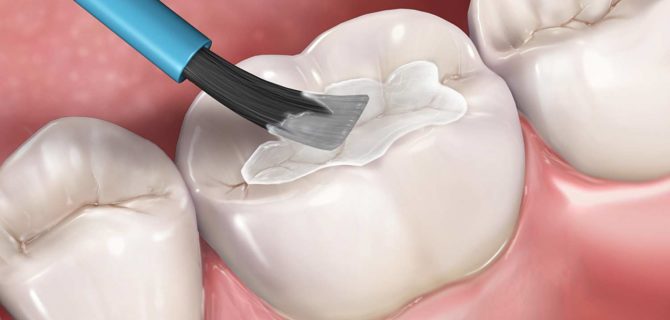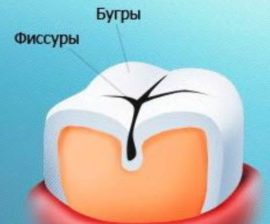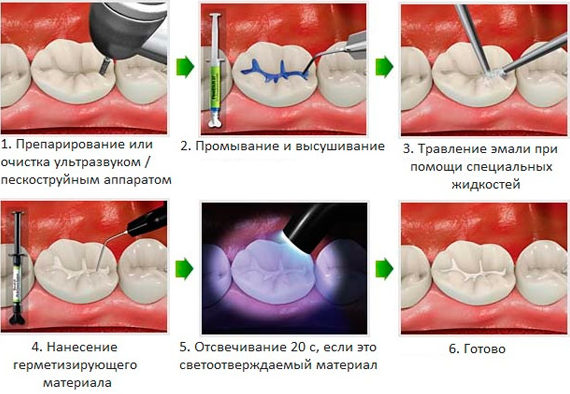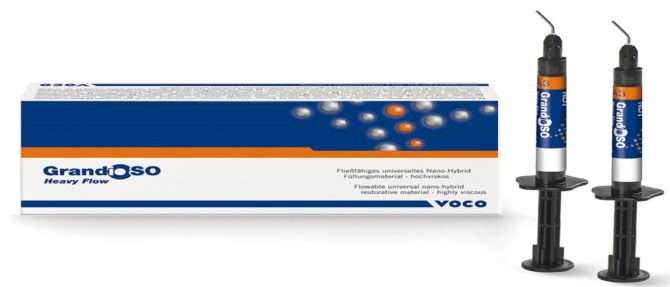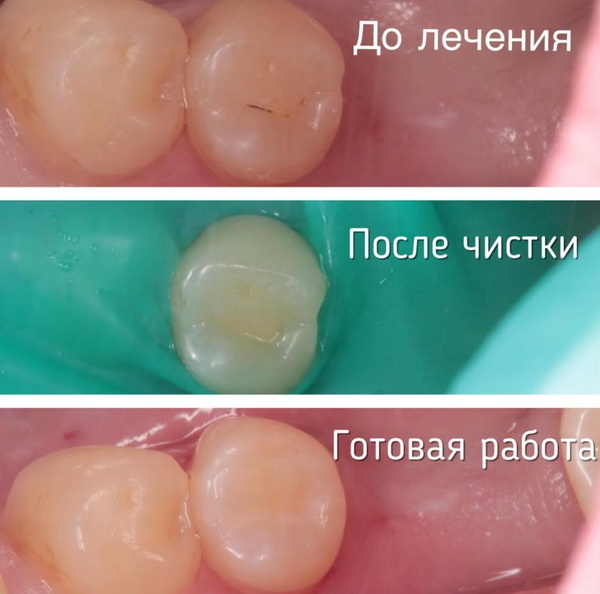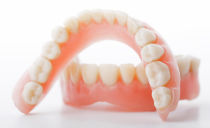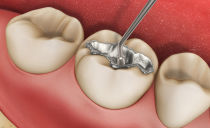Sealing fissures of teeth in children and adults: what are these, pros and cons
A few years ago, few people heard about sealing fissures in children. Today the situation has changed: parents are constantly using this service, performing fissure processing not only for their babies, but also for themselves.
Content
What is fissure?
A close examination of the chewing surface of the teeth reveals protruding tubercles and small grooves between them. These grooves are called “fissures”, literally translated fissure means “gap”.
Deep narrow slots create all the conditions for trapping small food debris in them, accumulating mucus, and multiplying harmful bacteria. It is extremely difficult to clean them with a toothbrush or a toothpick, so they often cause tooth decay.
Types of fissures
In dentistry, it is customary to divide fissures into types according to shape. Despite all their diversity, any, even the most intricate instance can be attributed to one or another group. The main types of fissures:
- polypous;
- teardrop-shaped;
- funnel-shaped;
- shaped like a cone.
The depth of the gap of any kind can reach 3 mm on the teeth of adults and 0.25–2 mm on children's teeth.
What is fissure sealing
Sealing is the sealing of fissures with a special composition. During application, the composition maintains elasticity, so the doctor can easily and accurately distribute it on the treated tooth surface.
As it hardens, the substance hardens and adheres tightly to the enamel, due to which absolute sealing of the fissures of the teeth is achieved, which has already proved its effectiveness in combating tooth decay.
Indications for the procedure
As a method of prevention, fissure sealing is used to treat permanent teeth. Experienced dentists use another effective method to preserve milk teeth - applying high-fluorine dental varnishes.
Direct indications for sealing fissures of permanent teeth are:
- Incomplete mineralization process - saturation of tooth enamel with fluorine and calcium compounds. It is observed in all children and adolescents under 16 years of age.
- Large size fissure recess.
Today, doctors insist that teeth sealing is a procedure necessary for all children who are at the stage of formation of a permanent bite. Since the teeth tend to erupt gradually, and not at once, you will have to make several visits to the dental clinic.
Note! The sealant will be especially effective when sealing teeth that appeared no earlier than three years before treatment. After eruption, the enamel is especially susceptible to caries - timely protection will protect the health of the teeth and reduce the financial costs of treatment and filling.
Contraindications to the procedure
The main contraindication to sealing fissures is the already begun carious process. Caries does not need a constant supply of air, this disease is actively developing in a dark enclosed space. Therefore, having applied sealant, the doctor will only aggravate the situation by directing the destructive force of caries towards dentin and root. This warning applies to the sealing of fissures in adults, and the treatment of fluoride varnishes of baby teeth in babies.
How it's done
Sealing teeth is a simple and completely harmless procedure, especially if the dentist chooses non-invasive technology. The choice of sealing method is carried out taking into account the diagnostic examination and the results of radiography.
Non-invasive sealing
Non-invasive technique is designed to seal open fissures - cracks that are fully accessible for inspection. The algorithm of actions of a dental technician may vary depending on the state of the oral cavity, but the approximate order looks like this:
- Cleaning chewing teeth that are not affected by caries.
- Sealant application.
- Polishing surface.
It is impossible to make a tooth completely flat, because without lumps, it will cease to fulfill its main function - to chew food easily and of high quality. Therefore, doctors always try to maximally accurately repeat the natural form of the chewing surface, sealing only cracks.
Invasive sealing
If there are too deep or narrow cracks, the doctor can not guarantee the absence of caries in them. In addition, they cannot be completely filled with a sealing compound, so doctors have to use a drill. With its help, the doctor expands the fissure space, makes sure that there is no caries and seals the gap with sealant.
Sealing Materials
Modern pharmaceuticals do not stand still, every day the drugs themselves are improved, and the form in which they fall into the hands of doctors. Dentistry is no exception. In the case of tooth sealing, the novelty is convenient disposable syringes already filled with sealant.
As materials are used:
- Compomers are fairly fluid and humid tolerant substances that wear out on average over two years.
- SIC - glass-ionomer cements, allowing to do without preliminary processing of enamel.
- Composite resins capable of protecting a tooth from carious decay for 6–7 years and even more.
Sodium fluoride is often included in the composition of materials, due to which mineralization of a permanent tooth with fissure filling continues for one and a half years after the procedure.
Sealants can be colored, having the shade of tooth enamel or completely transparent. The former are extremely rarely used for the treatment of adult enamel - usually adult patients speak out against fissure staining. But children and adolescents with great pleasure agree to multi-colored fissures and fillings.
Sealing fissures in children: the pros and cons
Despite the many positive properties of the procedure, the method of sealing fissures in children has opponents. Their main reasons are:
- Sealing milk or permanent teeth is an interference with the natural development of the dentition.
- Sealing fissures of milk teeth with varnish, as well as applying a sealant with a constant bite, weakens the local immunity of the oral cavity, "free" the body from fighting bacteria.
- The doctor may not notice the incipient caries and seal a bad tooth.
Those who advocate for the procedure say that sealant for teeth is necessary for children to:
- Effective caries prevention.
- Saturation of tooth enamel with useful trace elements.
- Increase tooth strength.
Dentists more often support the need for procedures for children and adults. And those who are against it, point to the painlessness of the treatment, the positive reviews of patients who have already undergone dental treatment and the safety of materials.
Seal or not
It is necessary to treat the chewing surface with a sealant or not - everyone decides for himself and his child. Official dentistry has long adopted the method of sealing as one of the most effective in terms of prevention. The results of professionally performed processing in photographs, which show the masticatory surface of the posterior tooth before, during and immediately after the doctor's manipulations, are especially evident.
Those who oppose the procedure or fear for the quality of its implementation can be advised to receive consultations of several specialists from different clinics at once. You can choose suitable candidates according to the reviews of the same patients. By comparing the opinions of several competent professionals, it will be easier to decide in favor of sealing.

